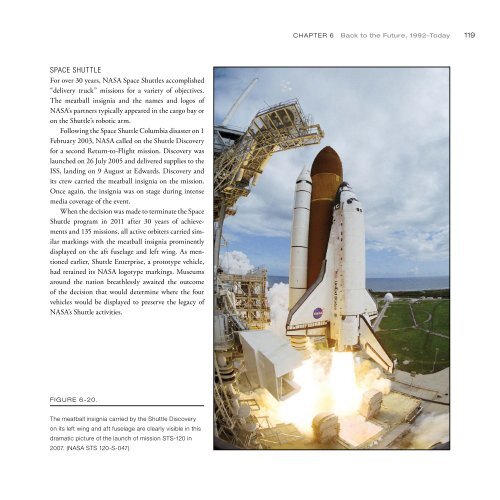Create successful ePaper yourself
Turn your PDF publications into a flip-book with our unique Google optimized e-Paper software.
CHAPTER 6<br />
Back to the Future, 1992–Today<br />
119<br />
SPACE SHUTTLE<br />
For over 30 years, NASA Space Shuttles accomplished<br />
“delivery truck” missions for a variety of objectives.<br />
The meatball insignia and the names and logos of<br />
NASA’s partners typically appeared in the cargo bay or<br />
on the Shuttle’s robotic arm.<br />
Following the Space Shuttle Columbia disaster on 1<br />
February 2003, NASA called on the Shuttle Discovery<br />
for a second Return-to-Flight mission. Discovery was<br />
launched on 26 July 2005 and delivered supplies to the<br />
ISS, landing on 9 August at Edwards. Discovery and<br />
its crew carried the meatball insignia on the mission.<br />
Once again, the insignia was on stage during intense<br />
media coverage of the event.<br />
When the decision was made to terminate the Space<br />
Shuttle program in 2011 after 30 years of achievements<br />
and 135 missions, all active orbiters carried similar<br />
markings with the meatball insignia prominently<br />
displayed on the aft fuselage and left wing. As mentioned<br />
earlier, Shuttle Enterprise, a prototype vehicle,<br />
had retained its NASA logotype markings. Museums<br />
around the nation breathlessly awaited the outcome<br />
of the decision that would determine where the four<br />
vehicles would be displayed to preserve the legacy of<br />
NASA’s Shuttle activities.<br />
FIGURE 6-20.<br />
The meatball insignia carried by the Shuttle Discovery<br />
on its left wing and aft fuselage are clearly visible in this<br />
dramatic picture of the launch of mission STS-120 in<br />
2007. (NASA STS 120-S-047)


